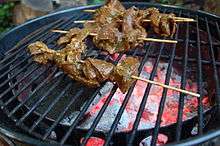Anticucho
Anticuchos (singular anticucho, Quechua for cut stew meat) are popular and inexpensive dishes that originated in the Andes during the pre-Columbian era. The modern dish was adapted during the colonial era between the 16th and 19th centuries and can now be found in Peru, Bolivia, Argentina and Chile.
Anticuchos can be found on street-carts and street food stalls (anticucheras). The meat may be marinated in vinegar and spices (such as cumin, ají pepper and garlic). While anticuchos can be made of any type of meat, the most popular are made of beef heart (anticuchos de corazón). Anticuchos often come with a boiled potato or bread on the end of the skewer. A similar dish, shish kebab is found in Mediterranean cuisine. In Peru, anticuchos are linked to the procession of Señor de los Milagros.[1]
History

Anticuchos can be traced as far back as the 16th century, when they were first encountered by the Spanish conquistadors. It was at this time that European ingredients such as garlic were added, and beef began to replace the traditional llama that was used at the time of the Inca Empire.[2] It was a popular dish among the inhabitants of the Inca Empire, and it is currently popular throughout most South American countries. Americanized versions of anticuchos are sometimes made of non-organ meats.
According to the text file from the National Library in Lima (Peru), it is believed that the term comes from the Quechua antikuchu (anti: 'Andes' + kuchu: 'court' or uchu: 'porridge, mix'). The writer Erika Fetzer mentions that according to tradition, anticuchos were prepared with meat and flame. The Spanish strung the meat on sticks as skewers.
The Spaniards also brought enslaved blacks, which were established in Lima and the coast of southern Chico de la Ciudad de los Reyes of the Vice-royalty of Peru. They adopted this dish.
In those days the Spanish dismissed offal as food for slaves, using non-offal meats out of the desire to have a dish that was more attractive to them. The presently used recipe, with its traditional flavor, specifically uses beef heart. In Peru, the tradition continues with the traditional name and ingredients; anticuchos are consumed by all social classes of Peru, and is especially popular as a street food.
Peruvian Ricardo Palma's speeches, Tradiciones Peruanos were published in 1833, mention the sale of anticuchos at 3 in the afternoon.
Anticuchos in the Andes
Traditional anticuchos are made with beef chunks of about 5x5 cm and onions, roasted on a metal skewer about 40 cm (16 in) long and 3 x 3 mm in diameter.
Anticuchos are commonly prepared with different types of beef and to a lesser extent with chicken, usually cut into pieces of 2 x 2 cm, threaded on a skewer of no more than 30 cm (12 in) long, with pieces of vienna sausage and vegetables such as onions, peppers, carrots and mushrooms alternated on the skewer, just like cooking meat on a barbecue (asado).
Usually they're seasoned with salt to taste and sometimes with vinegar or lemon juice. A popular dressing is a sauce made from garlic, onion and chopped cilantro, vinegar, lemon juice and beer, which is spread onto the anticuchos with a sprig of parsley.
Anticuchos are, usually not the main course of a meal, but rather an accompaniment to grilled meats along with other side dishes such as choripanes, potatoes, sausages and salads.
Variants include smaller sticks of wood; those 15 cm or less are called "meat skewers."
Anticuchos are part of traditional Peruvian cuisine. The greatest consumption in Peru is in July, during the celebration of Fiestas Patrias (Independence day) in fondas and BBQs.
In Bolivia, anticuchos are made with heart meat (commonly beef or chicken), accompanied with roast potatoes and a type of peanut sauce.
See also
- Şiş kebap
References
- ↑ Celebrating Peru’s Independence Day, Pt 1: Traditional Anticuchos 2012-07-24. Retrieved: 2012-07-31.
- ↑ "Anticuchos: Peruvian Beef Kabobs". Arousing Appetites.
External links
| Wikimedia Commons has media related to Anticucho. |
| Wikibooks Cookbook has a recipe/module on |
